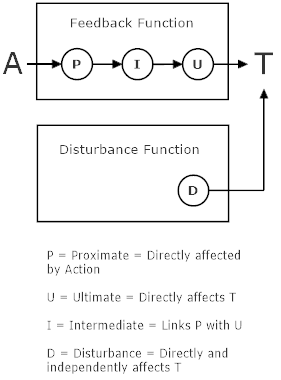[From Fred Nickols (2016.07.03.0753 ET)]
Thanks, Martin. My questions have to do with my efforts to integrate PCT with my consulting practice; in particular, the notion that change is indirect, that is, you don’t change “it,” you change something else and it changes as a result. Hence the notion of proximate, intermediate and ultimate variables. Those in turn tie to the feedback function – or so I think. More specifically, when we are trying to control some variable that is far removed from us in space and/or time, we are facing with having to change some things “over here” in order to realize the desired result “over there.” Thus our actions (A) tie to our target (T) the variable we are trying to control/affect by way of the feedback function which, to me, contains proximate, intermediate and ultimate variables. The diagram below should illustrate.

My approach usually involves mapping the larger structure in which the Target variable is embedded and then looking for variables we can affect through direct, immediate action and the effects of which will “ripple through” that structure, eventually making themselves felt on the Target variable.
Does this make sense?
Fred Nickols
image0012.emz (5.25 KB)
···
From: Martin Taylor [mailto:mmt-csg@mmtaylor.net]
Sent: Thursday, June 30, 2016 12:00 AM
To: csgnet@lists.illinois.edu
Subject: Re: The Feedback Function
[Martin Taylor 2016.06.29.23.49]
[From Fred Nickols (2016.06.29.1240 ET)]
Not long ago, Dag Forsell, “nitpicked” my PCT diagram, indicating that it did not include a “disturbance” function. Instead, it showed the disturbance going directly against the controlled variable or input quantity. I added the disturbance function.
That fix led me to revisit the “feedback function” which, as I understand it, is the means, mechanism or path by which output affects the input quantity or controlled variable. I’ve got some questions about that.
Let’s suppose I want to register for a test (I’m going back to my days at ETS). I am controlling for being registered for the test. To do that, I have to obtain, fill out and submit a registration form. That involves things like extracting the registration form from the test bulletin, getting a pen or pencil, reading and following the instructions for filling out the form, checking to make sure I’ve filled it out correctly, making any necessary corrections, folding the completed registration form, inserting it in an envelope, sealing the envelope, affixing a stamp, and placing it in the mail box. Hopefully, before long, I receive an email notifying me that I am registered and providing me with the time, date and place of the test administration. Voila! I am registered.
There are lots of different “outputs” along the way. Lots of different reference signals at work. And lots of levels of the HPTCT hierarchy involved.
But, at its most basic, it seems to me that the “feedback function” related to my goal or reference of being registered to take the test, consists of and involves all that stuff I mentioned above.
Do I have that right?
In a word, “Yes”.
In more words, the feedback function includes everything that happens between the output of the control unit, which is its contribution to lower-level reference values (except for the very lowest-level outputs that are directly connected to muscles), and the inputs to its Perceptual Input Function. Almost all environmental feedback functions include many lower-level controlled variables, as well as inanimate connections such as wires and radio signals in the physical environment of the organism.
One has to be careful not to be misled into thinking of the environment of a control unit as starting at the skin of the organism. It starts at the distribution to lower levels of the output of the output function of the unit and continues to the collection from the lower levels of contributions to its perceptual input function. So the controlled perceptions you mention are indeed parts of the feedback function of the controller of the perception " myself registered for the test" which starts with some error (reference value “yes”, perceptual value “no”) and if you did everything right ends up with no error (reference and perception both “yes”).
Martin
